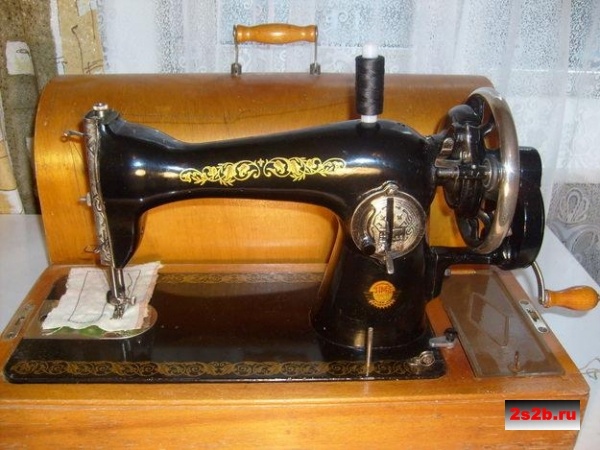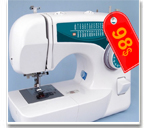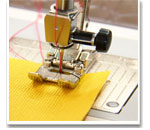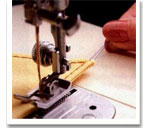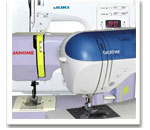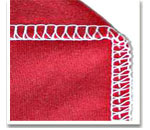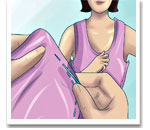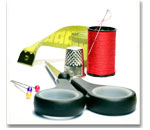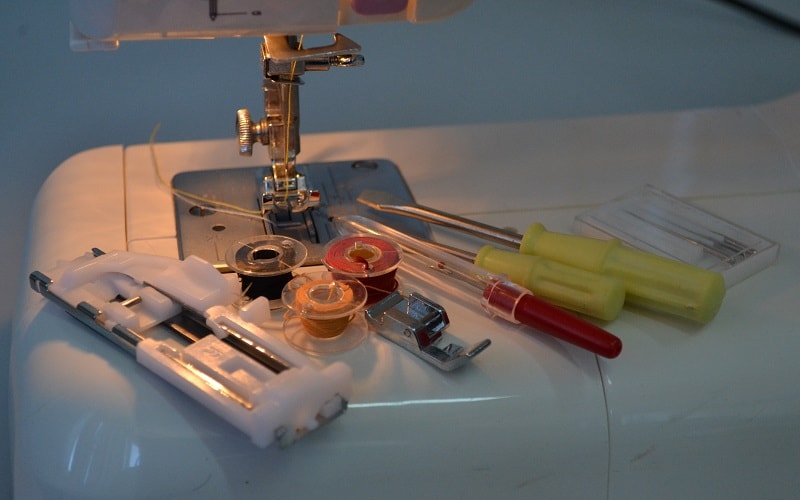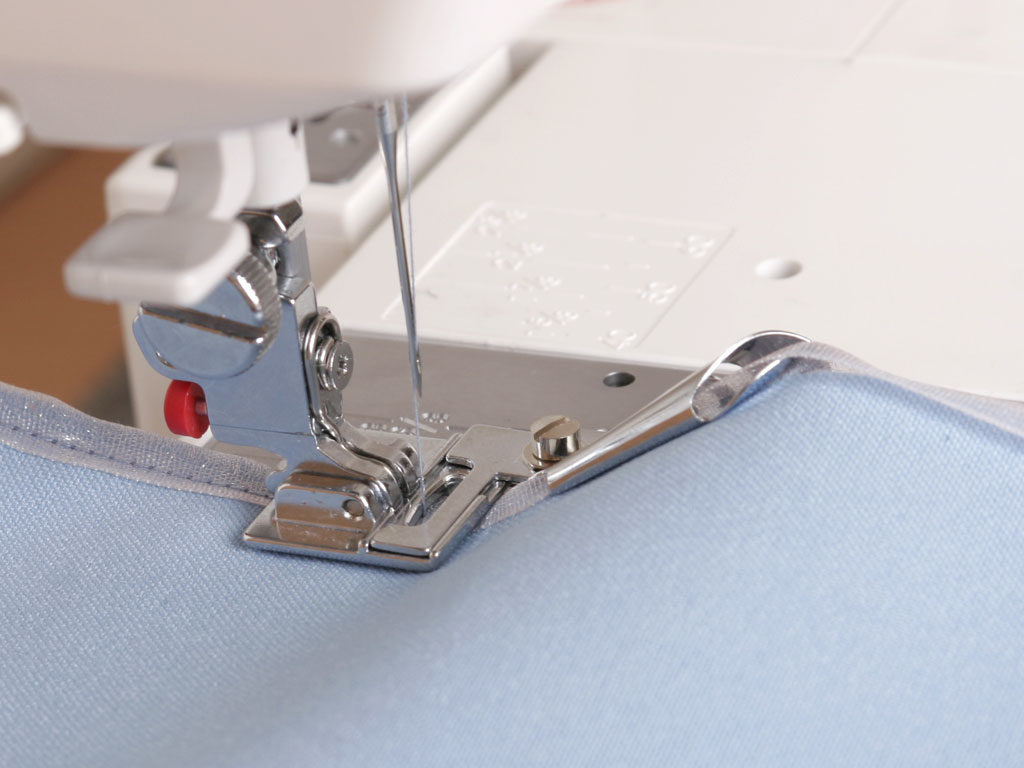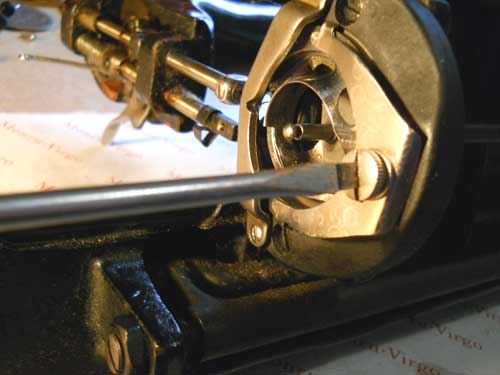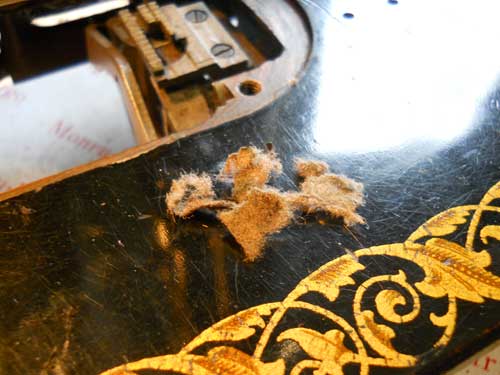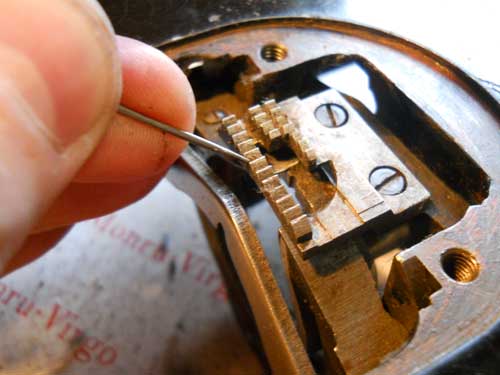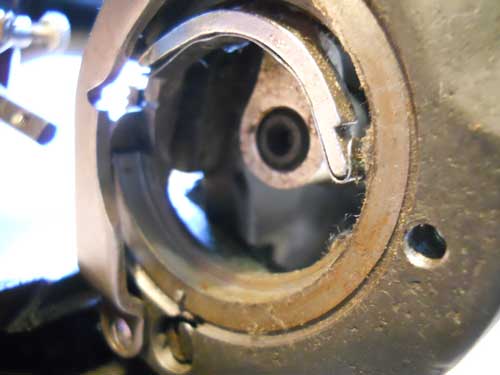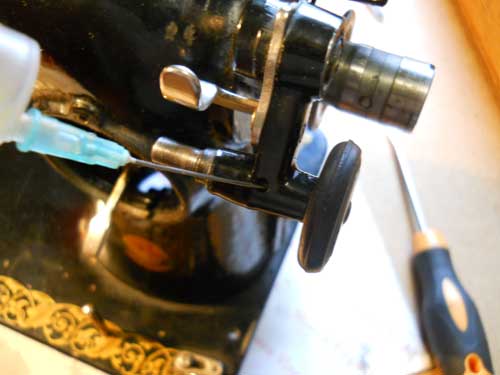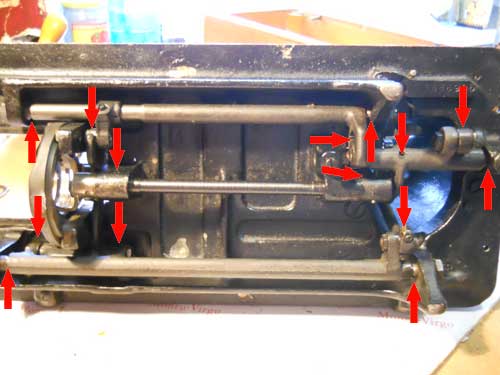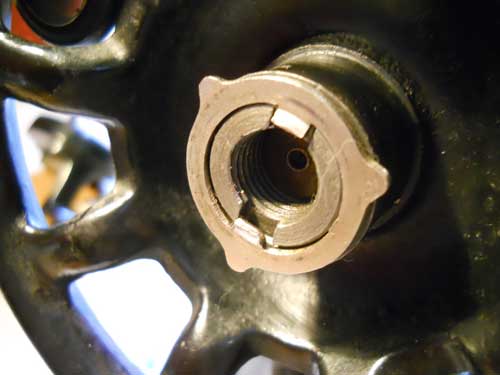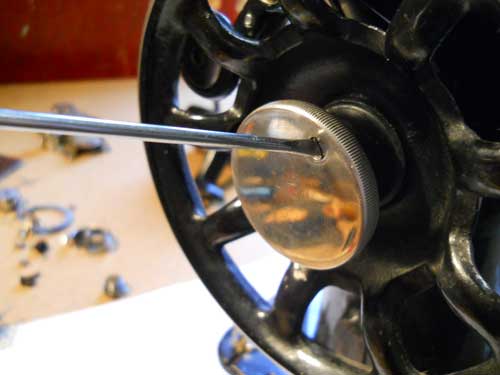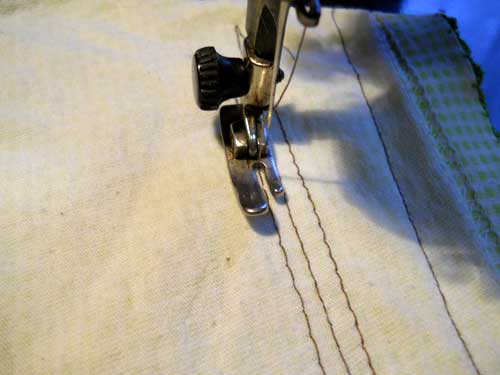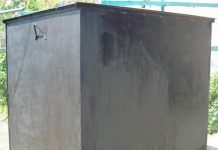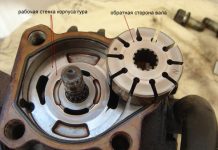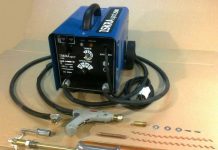In detail: do-it-yourself manual sewing machine repair from a real master for the site my.housecope.com.
Complex repairs of sewing machines related to the adjustment of units and mechanisms can only be performed by an experienced master. But such repairs are rarely performed, only when a part breaks down at the sewing machine and needs to be replaced with subsequent adjustment.
Most often, the sewing machine starts to “play up” if the rules of its operation, specified in the instructions, are violated or if simple settings and adjustments are not followed.
The main reason leading to a sewing machine malfunction is sewing fabrics that are not intended for this sewing machine model. Sewing a double hem on jeans, replacing a zipper in a leather jacket or bag, etc. - this is the main reason for the appearance of gaps in the stitch, thread breakage, needle breakage. Sometimes this can even lead to a breakdown of the sewing machine, subsequent complex repairs associated with the replacement of parts.
This article provides basic recommendations on how to set up and perform a simple DIY repair of a sewing machine.
Oddly enough, but it is the needle that is the most important part of the machine. During its “life” it makes thousands of punctures in the tissue and is not always light and thin, so sooner or later the needle point becomes dull, and the needle itself bends. And if at least once the needle hits the metal part of the machine body, the tip will bend in the literal and figurative sense of the word.
However, do we pay attention to this? The needle seems to be intact, so everything is fine. But take a magnifying glass and look at its point, its blade will be bent to one side. How would such a point pierce the tissue? There is only one way - to break it.
| Video (click to play). |
Now let's see how such a needle will form a stitch.
The thread passing through the eye of the needle will catch on the curved point and “slow down”, creating excess upper thread in the stitch. Here is the first reason the loops appear in the stitching. Moreover, the curved tip will cause periodic thread breakage, especially in difficult to sew areas, when the upper thread is extremely stretched.
It turns out that sometimes the whole repair of a sewing machine consists only in replacing the needle.
Treat the needle with great care. Even if it outwardly has no blade defects and is not bent, try to change them more often anyway.
You do not need to throw out the used needles, as there are situations when the needles break one after the other, for example, when sewing a leather bag. Then remember about a jar of old needles.
Another reason for adjusting the sewing machine, especially the old manual machines such as Singer or Podolsk, is the incorrect insertion of the needle into the needle bar. The needle blade (fig. B) should be on the side of the hook nose. Remove the stitch plate and see if this is the case if the machine suddenly begins to twist and break the thread.
It often happens that a seamstress installs a needle from an industrial sewing machine into a household sewing machine. It is impossible to confuse a household needle with an industrial needle. A household needle has a special cut on the flask (Fig. B). But, nevertheless, it is the industrial types of needles that are installed. This absolutely should not be done. Firstly, you break the gap between the hook nose and the needle blade, hence the gaps in the stitches, and secondly, you risk damaging the sewing machine hook. Some commercial needles are noticeably longer than household needles and may touch the surface of the hook, scratch it or even damage the hook.
Figure (A) shows a diagram of how to check the curvature of the needle.Externally, the needle cannot be determined whether it is a curve or not, and if you put it on the glass (2), you can easily check the gap (1). Please note that an uneven, bent needle will cause gaps in the stitching and will break sooner or later.
To make the sewing machine “more confident” to work with fabrics that are difficult to sew, such as knitwear, stretch, thin natural and artificial leather, denim, needles are produced for sewing just such fabrics and materials. They have a special point shape and make it easier for the thread to pass through the fabric, almost eliminating skipped stitches and looping of the upper thread.
See Home sewing machine needles.
The thread looping in the stitching, as well as the characteristic knock during their operation, is perhaps the main difference between sewing machines with a zigzag, such as Chaika, Podolskaya 142 of all models. In short, the looping in the stitching occurs due to the uneven tension of the thread along its path: a broken compensation spring, rusty sole of the foot, the shuttle is incorrectly set, etc. However, it is impossible to set many parameters yourself without experience. Therefore, if you have a poor quality stitch, pay attention first of all to the condition of the needle, to the tension of the lower thread in the bobbin case, and whether the upper thread tensioner is working properly. Very often, children like to disassemble and assemble it, and after such a repair, the machine stops working.
It is sometimes necessary to repair the sewing machine Chaika quite often, and this is not due to the breakdown of parts, the parts are just very strong, but with the misalignment of the interaction of some units of the sewing machine, mainly the shuttle move.
Almost all of these tips for repairing a sewing machine Chaika can be used for other models of household machines.
First of all, check the nose of the shuttle with a magnifying glass; it should not have any chipping or rusty spots. If there are jags, they must be removed with a small file and polished to a shine, otherwise the thread will constantly linger behind the file marks and loops will appear below. Only this must be done carefully so as not to blunt the tip of the shuttle nose.
Sometimes the bobbin (the bobbin thread is wound around it) can cause repairs to the sewing machine. Yes, it is repair, since an inexperienced "master" often disassembles and assembles all the units, when it is enough to simply replace the old metal bobbin with a new plastic one. If the edges of the metal bobbin are jagged and the bobbin case itself is clogged with thread fleece, the bobbin thread will come out in jerks and the upper thread in the stitching will periodically loop from below.
Often the reason for contacting a sewing machine repairman is that the upper thread is poorly regulated. You are tightening it almost completely, but the tension is still too weak. Look, perhaps, between the tensioner plates, thread fluff has accumulated, which prevents the washers from fully squeezing. The fastening of the tensioner (Chaika) may have loosened.
But still, most often, sewing machines such as the Seagull have a malfunction in the parameters of the shuttle and the needle. This is a complex type of repairing a sewing machine, more precisely setting, but for general information it is advisable to know the main reason due to which all the "troubles" of sewing machines occur.
The most common cause of a sewing machine malfunction is the upper thread. Thread breakage, looping in a stitch, uneven stitching, skips, etc. This often depends on the upper thread tensioner.
It is the fastening of the tension regulator (Seagull) that most often causes its poor performance. The plastic body is pressed under the pressure of the screw and over time the tensioner begins to stagger, or even completely "falls out" of the body.
In this photo, arrows indicate the attachments of the needle bar and tensioner. When sewing rough fabrics, intersecting seams on leather goods, and especially when hemming jeans, the needle bar may move upward with the needle.
Loosen the screw slightly and adjust its position, making sure that the blade and needle groove are in the correct position in relation to the hook (not turning left or right).
For details on how to disassemble and assemble the sewing machine tensioner, see the article "The device of the sewing machine tensioner Chaika".
Adjusting the shuttle mechanism of sewing machines performing zigzag stitching by Chaika, Podolsk, Veritas and others implies setting the position of the looper point above the needle eye by 1.2 (3) mm at the moment the looper point approaches the needle. This parameter is checked when the sewing machine sews not only the straight stitch, but also the left and right needle drop (when sewing the zigzag stitch).
The point of the shuttle must at the same time pass almost closely to the blade of the needle - this is the second condition that allows you to form a stitch without gaps.
In this photo, the arrow indicates the fastening of the shuttle shaft. Loosen the screw with a 10-point wrench, and holding the handwheel by hand, you can turn the shaft (together with the shuttle stroke) by adjusting the position of the hook point in relation to the needle.
However, these are not all the parameters for adjusting the interaction of the hook nose and needle. There is such a parameter as the timeliness of the approach of the shuttle nose to the needle, namely at the moment when the needle starts to rise. The needle descends to the lowest point, and when raised by 1.8-2.0 mm, it should meet the nose of the shuttle, the shuttle removes the loop from the needle and wraps around itself.
But that's not all. For sewing machines performing a zigzag stitch, there is such a thing as right and left needle prick. With the left and right prick of the needle, the nose of the shuttle should “confidently” remove the loop formed above the eye of the needle. It should run slightly above the eye of the needle, but less than the distance of the eye of the needle itself, about 1 mm.
However, such adjustments are often not required to be performed, it is enough just to check with a magnifying glass how the shuttle interacts with the needle and make sure that repairs, adjusting the sewing machine are not needed, and look for another reason. For example, change the threads, thread them correctly, change the needle, clean the shuttle from dust and fleece, etc.
To make it easier for you to repair the sewing machine, disassemble the shuttle move and study its device. Observe how the stitch is formed when the stitch plate is removed. At the same time, check all the shuttle settings described above. See also How the sewing hook works.
The settings above can be used as a guide if you decide to repair your sewing machine yourself. As a rule, the machine will work normally with such gaps, but if you need to sew knitted fabrics that are too thin (silk) or, on the contrary, thickened fabrics, you need a more accurate adjustment of these parameters, which can only be set by the master.
In many cases, sewing machine repairs will not be necessary as long as the sewing machine is kept clean and lubricated periodically. If a seamstress takes care of her machine, then, therefore, she will protect it from overload during work, not let it into the “wrong” hands, which means that the sewing machine will break less often.
After prolonged operation, clean the bobbin compartment and other accessible places from dust, fleece, oil stains. The shuttle itself, the shuttle mechanism, should be periodically cleaned with a stiff hair brush. It is advisable to lubricate the machine at least once every six months, and after lubricating it a little “idle” on it, especially if the machine is not used for a long time. During operation, the oil heats up slightly and better penetrates into units and places of friction.
It is better to draw machine oil into a medical syringe and bury it in small drops in accessible places where there is friction of metal parts.
The big enemy of all mechanisms is dirt and rust, try to keep the car in a cool, dry place.If the machine will not be used for a long time, protect it from dust, otherwise the oil from the dust will harden, and the machine will turn tightly, or even jam. This case is considered in the article Podolsk Manual Sewing Machine.
In this article, we will figure out whether such a combination is possible - "an inexpensive and good machine" and how an inexpensive sewing machine that costs 3-4 thousand rubles differs from a machine that costs 30 thousand.
Many who tried to sew knitwear on an ordinary sewing machine noticed that the machine often refuses to make a beautiful and even stitch. There are gaps in the knitted stitching, the lower thread loops and sometimes breaks. Why is this happening and how can you fix it?
The coverlock is a modern and versatile machine that can overcast fabrics, sew cover stitches and even stitch parts like a regular sewing machine. But it is impossible to repair such a sewing machine with your own hands, you must definitely contact the service center.
Sometimes it is required to make a perfectly even decorative stitching on a product, but you cannot draw a line with chalk - traces will remain, and there is not enough experience to scribble "by eye". Simple tips on how to sew on “difficult” areas.
For those who rarely sew simple products or occasionally perform minor repairs on clothes, you can buy an inexpensive economy-class sewing machine. It performs almost all operations, is easy to operate, and most importantly, for such a machine, it will be cheaper to build repairs if suddenly it is needed.
The overlock is much more complex than sewing machines. It is almost impossible to repair an overlock without special knowledge and skills. However, repair or adjustment is not always required, sometimes it is enough just to adjust the thread tension and it will again overcast the fabric with high quality.
How to sew a dress with your own hands. Technology and sequence of sewing dresses for beginners.
How to make a pattern, what tools are needed for this. These and many other tips for beginners.
Sewing machines do not lose their popularity even in the twenty-first century. Those who were born in Soviet times remember that girls were taught from childhood to sew various things, from gloves to jackets and coats.
During the Soviet era, most people did their own sewing machine repairs. Even today, those who attend sewing and sewing courses understand that it is better to repair a sewing machine on their own than to take it to a service center:
- Firstly, companies that repair sewing machines demand quite a lot of money from their customers for the services they provide.
- Secondly, the device of even modern machines can be figured out in a matter of hours, one should only carefully approach this issue, and in the future this will allow repairing sewing machines without involving third parties.
Let's take a look at the basic rules for operating sewing machines:
- Sewing equipment should not be placed near batteries or heaters. But at the same time, it should be in a dry room, in which there are no signs of dampness;
- Before starting work, it is necessary to select the necessary materials and tools, needles and threads that will be needed in the process of work;
- Before you start sewing, you need to make sure that the needle and thread guide are in the up position;
- Remember that the sewing machine must be helped at the time of sewing by pulling the fabric towards you;
- After the sewing work is finished, raise the presser foot and pull out the fabric.Next, cut the thread, finding a free end in advance, the length of which will be equal to a maximum of seven, but at least five centimeters.
There are rules and they must be followed. The use of quality materials and additional tools minimizes the occurrence of problems and malfunctions when working with sewing machines. Therefore, the following reasons, which led to malfunctions, are the most common:
- Broken thread. Breakage can occur both with the upper and lower threads. In the first case, the problem is associated with the selection of low-quality threads or the size of the needle is not correctly selected. In the second case, the problem of a malfunctioning sewing machine may be associated with irregularities, the presence of burrs in the bobbins, and with improper winding of the thread.
- Problems with advancing the fabric. If such a problem arises, you need to carefully look at the position of the teeth. If they are lifted up or lowered to the bottom, then it is required to bring them to a normal state;
- Cutting through the fabric. If such a problem arises, in order to fix the machine, we need to reduce the pressure of the presser foot, and check the condition of the needle, it may be too dull.
The above problems are not serious, and are eliminated in a matter of minutes. But there are some types of problems that occur infrequently. Therefore, repairing sewing machines with your own hands, if they occur, will take a lot of time.
The most difficult, most serious breakdown should be considered the appearance of a knock when the sewing machine is running. To solve this problem, it is necessary to pull the flywheel several times, and do this in accordance with the axial direction of the machine.
In order to repair the sewing machine, it must be disassembled. We disassemble the sewing machine in the following sequence:
- Remove RP (manual drive). It is necessary to remember its location, this will allow you to subsequently assemble a sewing machine in a short period of time;
- Unscrew the stopper from the nut, which is a classic screw. It is under a manual drive, at the time of assembly it must be screwed back to its original location;
- Remove flywheel. This must be done carefully, avoiding damage to it, in the event of a malfunction of the flywheel after assembling the machine, you need to see if everything is in order with it;
- Remove the bobbin that looks like a taper. It is located below, after the flywheel. Finding it will not be difficult;
- Remove the bushing from the shaft base;
- Slide a tin washer onto the shaft. It is very simple to make such a washer, just cut out the bottom of a tin can.
The washer in 40% of cases is a guarantee of high-quality performance of work using a sewing machine. Sometimes adding it to the typewriter is enough to solve the problem, but this does not always happen. When adjusting the operation of sewing machines, in 60-70% of cases, it is necessary to turn the rail 180 degrees.
The needles are the basic elements that make the sewing machine work. Its further work depends on which needle is chosen. If a defective needle is picked up, then the occurrence of the above problems is not a rare case, because the needle is the basis, and without it it is impossible to sew a single thing.
Therefore, when choosing a needle, you must carefully consider its size and thickness. You also need to check the numbering of the needle if any complex sewing work is being carried out, otherwise it may happen that the thing does not turn out the way you imagined it earlier.
There is another problem in which the wrong choice of a needle can lead to stretching and damage to the tissue. If the needle is too thick and the fabric is thin, then you cannot use the needle with such fabric, otherwise it will break.
Using too thick fabric with a small needle may break the needle. In order to sew something from a compacted fabric, you need to choose a thicker needle, if it is not available at home, then go to the store and purchase it.Before doing this, measure the thickness of the fabric in advance - this will allow you to choose a needle in the store in a shorter time, you will need to tell the seller the thickness of the fabric, and he will independently select the needle of the size you need.
In the event of a serious breakdown of the sewing machine, only a competent specialist can help it. Although, in most cases, as practice shows, complex repairs to a car operating at home are not required, and in order for it to be used, it is only necessary to adjust and adjust it. And it is quite possible to do this on your own, the main thing is to learn and understand how to properly set up the sewing machine before work and which parts should be adjusted in it.
How to set up and adjust the sewing machine
The main malfunctions that require timely adjustment and adjustment are:
- instability of the stitch, consisting in the formation of gaps in the line, different lengths of threads, breakage of one of them or both at once;
- manifestation of irregularities in the line, namely, the tightening of the fabric in the form of an accordion, excessive pulling or loosening of the loop, as well as bevelling the line;
- change in travel, accompanied by noise, the appearance of "heaviness" or jamming.
The occurrence of all these malfunctions suggests that you need to look closely at the operation of the sewing machine, determine the cause of their occurrence and try to eliminate it. If you do this at the very initial stage, then it will not require much effort. Prolonged operation of the sewing machine in the wrong mode may require expensive repairs, which can only be carried out by a professional.
Read also how to fix the problem if the sewing machine starts to break the upper thread.
Setting up a sewing machine with your own hands is quite simple. To do this, you must adhere to a certain sequence of actions, the main stages of which are:
The importance of correct presser foot pressure
Electrically operated sewing machine pedal
Among other things, the stitch length must be set before starting work. Usually, their exact value for various types of fabric and a particular line is indicated in the instruction manual of the device. In this case, the average value of this value is from 1 to 2 mm when using thin fabric and not less than 3 mm - thick fabric. It is also worth checking the sharpness and fit of the sewing needle. If the needle is blunt or too thin for a particular fabric and thread, skipped stitches will occur.
You can find out about the rating of the best sewing machines from our article.
No matter how strange it may seem, the needle is one of the most important elements of the sewing machine, so before wondering how to properly set up the sewing machine, you need to check this element. During the stitching process, the needle makes several hundred punctures in the fabric, some of which are not fine or light. Over time, this leads to its dullness, and subsequently to the fact that it bends. And in the event that, in the course of its movement, the needle hits the metal of the device body at least once, then the tip will surely crumple. At the same time, inexperienced craftsmen may not pay attention to such an incident and, upon visual inspection, will not notice the defect that has arisen. But in fact, it will exist, and when the tissue is punctured, it will form relatively large tears on the latter. The thread, which passes through the eye of the needle, will cling to the deformed point, slowing down with the appearance of an excess of it in the stitch. Loops will begin to form in the stitching. In addition, a bent, blunt needle can cause the thread to break off permanently, especially when sewing a difficult section of the product when the upper thread is taut as much as possible.
In such situations, setting up and adjusting the hand-held and electric sewing machine is not required per se. And to do the job normally, you just need to replace the needle yourself. This element in the car must be changed as often as possible. This will not complicate the work in any way, but on the contrary will make the sewing really high-quality and accurate.
When replacing the sewing needle, it is necessary to select this element strictly corresponding to the type of machine. Under no circumstances should a needle intended for an industrial sewing machine be inserted into a household appliance. It is extremely difficult to confuse them, since needles for industrial devices do not have a saw cut on the flask. When using such a needle in a household sewing machine, the gap between the needle blade and the hook nose is disturbed, which, at best, leads to skipped stitches. And at worst, damage to the sewing machine shuttle. It is also very important to correctly position the element in the needle holder, which consists in finding the blade from the side of the hook nose.
Before inserting even a new needle corresponding to the type of sewing machine into the needle holder, you need to make sure that there is no curvature, which at first glance may not be noticed. To make sure the needle is perfectly straight, you can place it on a glass or mirror. The gap will be visible immediately. In addition, you need to choose a needle in accordance with the fabric used. So for sewing "complex" fabrics, such as stretch, jeans or artificial leather, there are special needles that have a special shape that facilitates better passage of the needle through the fabric, thereby eliminating skipped stitches and uneven loops created by the upper thread.
Select a needle according to the number of the used thread. In this case, it is worth taking into account the peculiarity of the new sewing machines, which consists in the presence of a guiding stop under the surface of the table, which does not allow the needle point to leave the side. In this case, the distance from it increases with increasing tissue thickness.
Needle selection based on fabric
Joint work of shuttle and needle
The quality of the result obtained during the sewing process depends on the setting of the shuttle unit and the needle of the sewing machine, or rather on the correspondence of the gaps between them to the correct values, in the absence of which gaps, looping and breaks of the lower and upper threads may also occur in the stitching. In order to make this setting, you need to understand how the machine works when forming a buttonhole.
So when the needle is raised 1.5-2 mm from its original position, a loop is formed from the upper thread, which is located slightly above the ear. In this case, the nose of the shuttle should pass almost closely from the hollow of the needle. This distance should not exceed 0.15 mm. In this case, the value from the nose of the hook to the eye of the needle should be 0.5 mm. These values are approximate and should be used with medium-weight fabrics. Depending on the type of material used, they may vary slightly. It is possible to understand their numerical value only experimentally in the process of performing work, and such skills in most cases come with experience.
It is also worth noting the importance of correct vertical positioning of the rack. They are responsible for moving the fabric relative to the needle and the body of the sewing machine during operation. At the moment when the needle pierces the fabric, the top edges of the rack teeth should be at the level of the working table of the sewing machine.
In order that each time before using the sewing machine it is not required to adjust it, it is enough to observe certain preventive measures, the main ones of which include:
- all main parts must be lubricated with special oil at least once every six months;
- after each use of the sewing machine, it is imperative to remove from its surface, as well as the cover of the shuttle and the needle plate, all dust and dirt formed during operation;
- before hiding the machine in a cover, you must make sure that there are no torn threads and fabrics in its structural elements, as well as placing thick paper or cardboard under the foot, lower it all the way;
- storage of the sewing machine must be carried out in a case;
- pedal and drive cords should be rolled up as carefully as possible to avoid twisting and tearing.
Proper storage of the sewing machine
Also you can read. how to properly thread, needle or bobbin into the sewing machine.
If the sewing machine has not been used for a long period of time, it must be checked and adjusted before use. This is necessary in order to make sure that in the process of long "standing" all the main elements and mechanisms did not corrode if stored improperly. To do this, lubricate all metal parts of the device with the oil that comes with the sewing machine. If it is not there or it is over, then you can use ordinary machine oil. Further, without lowering the foot, it is necessary to drive it wasted at a low speed, so that all elements that do not get oil are also processed by it.
After all these steps, you need to replace the sewing needle, and only then start threading and using the device. The first stitch is best done on a piece of unnecessary fabric in order to avoid the ingress of machine oil on the material of the product that will be made using the sewing machine. In this case, it will become clear whether the line is correctly laid down. After that, you can safely start working with complete confidence that this device is working properly and will not spoil the main fabric.
Thus, it is quite possible to set up the sewing machine yourself. The main thing is to understand what kind of problem arises in the process of performing work. All basic operations are standard and apply to both manual and electric sewing machines. If every time before using it, you check all the main parts and assemblies of the device, as well as take timely preventive measures and use it correctly in accordance with all paragraphs of the operating instructions, then the question of how to set up and adjust the sewing machine will not arise.
- Handicraft (1835)
- Knitting (1116)
- Sewing (417)
- Embroidery (266)
- Sewing (31)
- Zelnik (286)
- For face beauty (99)
- For healing (71)
- For hair beauty (62)
- For body beauty (49)
- Practices (207)
- Ladies (2)
- Healthy (134)
- Healing (110)
- Domostroy (82)
- Magic (69)
- Crystals (48)
- Star Reading (44)
- Chakras (40)
- Usefulness (40)
- Conspiracies (29)
- Pleiades (28)
- Vedas (25)
- Predictions (22)
- Mantras (22)
- Gayatri Mantra (4)
- Flowers (22)
- Life Rules (19)
- Charms (18)
- Reiki (18)
- Prayers (14)
- Yoga (11)
- Meditation (8)
- Ceremonies (7)
- Mudras (2)
- Channelings (1)
- Decoupage (1)
These machines are 40-50 years old, and they still sew, which cannot be said about modern imported consumer goods. I bought it and threw it away, and my grandmother's rarity is carefully kept, in many families, as a memory and as a masterpiece of Soviet industry.
Podolsk Mechanical Plant named after M.I. Kalinina produced such sewing machines of class 2-M.
Unpretentious, reliable, easy to operate, always rescued in difficult times, and allowed many to earn bread. It is a pity to see how young people are now getting rid of old things that can serve their masters for a long time to come. Most of these machines are now resting in a landfill. And earlier the sewing machine was affectionately called the nurse, she fed and sheathed the family.
It's time to get down to business.
First of all, we cut off the fabric that women love to sew on the “waist” of the machine.Believe me, there is no benefit from it, used needles, bent, blunt, are stuck into it, and then they try to reuse the same needles. And they cannot understand why this machine does not sew. In addition, after such sticking, the coating deteriorates and such scars remain. Used needles should be thrown into the trash can, where they should be.
We disassemble the machine, remove all covers, the stitch plate, disassemble the shuttle, as shown in the photo.
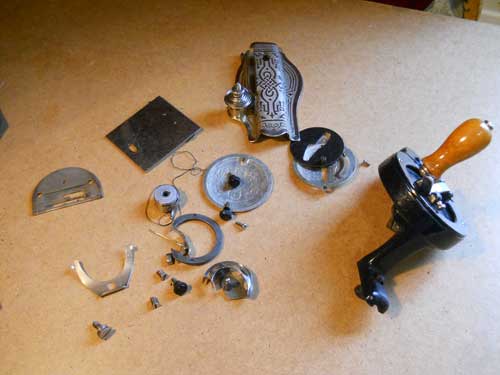
It can be seen that pile from fabric and thread has accumulated on the shuttle travel body, there are even pieces of thread and all this is mixed with thickened oil.
And here, too, dust and thickened oil.
And this is the place where no seamstress, during the entire operation of the machine, never looks. Lint and dust and sand accumulate here, in general, everything that gets into the holes of the needle plate.
We remove all this byaka with a needle and tweezers.
The toothed rack also needs to be cleaned; it is best to do this with a large needle.
And naturally we clean the shuttle, it is good to use kerosene for these purposes, if it is not there, then you can remove the thickened oil with a knife or screwdriver.
We removed all the dirt and old oil, now we start lubricating the machine.
For these purposes, it is best to use an ordinary disposable syringe, with the thickest needle possible. I do not advise you to lubricate with an oil can, it overflows the oil, and you will stain the machine, and you yourself will get dirty. The oil can be bought at any hardware store. Household Lubricating Oil will do.
Here, the arrows indicate the technological holes for lubrication, we bury 3-4 drops in each hole, no more.
And here it is imperative to instill in both holes, one hole of the needle bar and the other of the presser foot.
In these places, the needle bar is rarely lubricated at all, the friction is frantic and the metal is generated, a backlash is formed, as a result of which the needle hits the throat plate or the shuttle.
And accordingly, the foot should also move freely up and down. Without braking, otherwise the fabric will be unevenly pressed, it will simply walk under the foot and the stitches will be of different lengths.
And one more place that we must lubricate.
Winding a bobbin, dripping three drops of oil.
Now we put the machine on its side. The arrows indicate all the places that need to be lubricated.
After full lubrication, we turn the handle for a couple of minutes, so that the oil flows into all the joints and cracks of the machine mechanism. Feel the difference, it began to work completely differently, softly and quietly.
Pay particular attention to the installation of the friction device.
Here you can see how not to do it, usually amateurs install the friction washer this way, as a result, they do not turn on the working stroke. After which they begin to turn on their imagination, cut out the washers from cardboard, wind the wire, in general, who is good at what.
This is how the washer should be, the protrusions should be outward.
After that we tighten the friction screw and the stop screw.
The result of our work.
Do not store the sewing machine near heating appliances or in cold, damp rooms.
Cited 21 times
Liked: 7 users
The sewing machine is an indispensable unit for home seamstresses. But sometimes the machine stops sewing normally: the thread breaks or gets confused, a knock is heard when the unit is operating. In this case, repair or adjustment of the sewing machine will be required. If complex repairs are required with the replacement of parts and assemblies and subsequent adjustment, then it is better to entrust such work to a specialist. But more often than not the car starts to "be capricious", for a reason misuse, or if the rules for setting and adjusting specified in the instructions are not followed - in this case, it is quite possible to repair sewing machines with your own hands.
The most important part of the unit, oddly enough, is the needle. During service, she makes hundreds of thousands of punctures in both thick and thin fabric.Over time, the needle becomes dull, the load on it increases, as a result of which it bends and breaks.
If the needle strikes a hard surface, such as the metal housing of the machine or a button, it will the tip may bend... At first glance, the needle looks fine, but the stitch is not straight when sewing. This is explained by the fact that when the thread passes through the eye of the needle, it clings to the defect of the point. When this happens, it starts to slow down with the formation of excess upper thread that passes through the stitch. For this reason, a break occurs periodically, and loops appear in the stitching.
Very often the unit breaks down if the user tries to sew fabrics that are not intended for household appliances, for example, double folds on jeans, zippers on a leather jacket, etc.
Thus, the entire repair of this unit can be a simple replacement of the needle. This part should be taken seriously and changed as often as possible, even if there are no visible defects on it. You should not throw in used needles: they can help you out if a good needle breaks, but you need to urgently continue sewing.
Incorrect needle placement may also cause the sewing device to “whim”. This problem often occurs when repairing Singer sewing machines (with a manual drive), as well as Chaika 100 and others.
The needle blade should be facing the hook point (fig. B). If the thread is tangled on the machine, remove the needle and check if it is properly attached.
There are times when a seamstress purchases a part for industrial equipment instead of a needle for household machines and installs it. Although it is difficult to confuse household (Fig. B) with industrial. There is a small saw cut on a household needle. When installing industrial needles you may damage the hook because some types of this part are slightly longer than usual. Even if its length is normal, the correct gap, which should be between the hook nose and the needle blade, is still violated, as a result of which "gaps" appear in the stitching.
A bent needle can also be the culprit for skipped stitches. If you look at figure (A), it is easy to understand how to check the curvature of a part. Since it is difficult to determine the bend of the needle from the side, it must be placed on a piece of glass. By turning the part, if it is not bent, the gap (1) will not change.
As noted above, do-it-yourself repair of sewing machines can be done with minor breakdowns that do not require replacement of parts in the assembly units.
You should be aware that preventive cleaning of the device and timely lubrication of moving parts can prevent most problems in the device.
If there are gaps in the line, then the following factors may cause this problem.
- The fastener holding the needle is loose. To fix the problem, clamp the part with a screwdriver, wrench or pliers (depending on the model of the unit).
- The hook nose is blunt or bent during operation. Use a magnifying glass to check this. If a defect is found, replace the part with a new one.
- The needle selected for the fabric is too thick. Refer to your machine's manual for details on the selection criteria for fabric and needles.
- The thread selected for the small eye of the needle is too thick. Adjust the thickness to match the size of the eyelet of the needle.
- Incorrectly installed needle. Install the part as directed in the instructions. Usually the saw cut on the flask should be directed away from the seamstress.
- Factory marriage of a needle. Replace it with a new one.
In some cases, malfunctions that can be eliminated with your own hands are associated with broken threads (upper or lower), poor fabric advancement or problems with the needle. In other cases, you must contact the master.
Remember that the repair of sewing machines Chaika 142m, Phoenix or Podolsk with your own hands should begin with cleaning the unit from dust and lubrication of moving parts.
The upper thread can constantly break if tucked in poor quality thread, or it is generally incorrectly refueled. In different models of devices, the refueling scheme may differ, therefore it is necessary to study the instructions, and according to it, insert the thread correctly. If the thread number is incorrect for the needle, also refer to the manual. Also, the upper thread breaks when there is too much spring pressed... It is necessary to loosen the adjusting screw slightly with a screwdriver. This adjustment is often done when the Podolsk sewing machine is being repaired, as well as Dragonfly, Brother and others, since the bobbin cases in all models have a similar design. In addition, thread breakage may be due to improper needle placement.
At the bottom of the machine, the thread travels from the bobbin (small spool) through the bobbin case to the needle eye of the plate. The thread breakage can be due to its dense and uneven winding. You also need to check the bobbin is installed correctly.
The quality of the yarn plays an important role in the correct operation of the machine. If it is with hinges, then it will inevitably block under the spring, followed by a break.
Bobbin thread breakage is rare, and this defect is noticed more often in machines with a vertical shuttle. Burrs can form on metal parts near the needle when the needle is repeatedly deflected from its path. In most cases, it bends when the user pulls the material to be hemmed in order to “help” the typewriter to advance it. found burrs, they can be removed with fine emery paper, after which all moving parts of the assembly can be lubricated. After that, a small piece of fabric should be stitched so that excess grease is absorbed into it.
There are times when a sewing machine is being repaired Chaika, or a sewing machine is being repaired in Podolsk, as a result of which an incorrect location of the point through which the thread comes out of the bobbin case is found. The problem is solved by replacing the “native” cap with a similar one produced by JANOME. This solves the problem of breakage and also improves the quality of the seam.
Most often, looping occurs from the bottom, due to a weak upper thread tension, or careless threading. To avoid this problem, you need to set the machine foot to the lower position, and only after that pass the thread through all threading points, referring to the instructions. When lowering the presser foot, the plates close. tension regulator.
The thread must be wound with an interference that must be felt when pulling the thread in order to thread it into the thread take-up.
If the thread is not clamped in the plates, it means that a foreign object (a piece of thread) has got into the space between them and needs to be removed. In the event that cleaning did not help, it is required to disassemble the regulator. In older units, it is located outside, on the front of the unit. In new models of machines, it will be necessary to remove the lining of the apparatus in order to get to it, for example, when repairing the Chaika sewing machine.
Frequent breaks and difficult tissue advancement may be due to misalignment of the movement of the needle and the assembly of the movable rail. Since the setting of the rack and pinion unit may differ for each model of sewing machine, for example, if you take repair of Brother sewing machines, it is not possible to give universal instructions. But if you understand how this unit works, then you can configure it on any model of the unit.
-
The needle makes a simultaneous movement with the staff to the final lower position.
 The most important point in tuning is when the tip of the needle meets the barbs. The latter should be in a slightly lowered position relative to the needle plate, but not completely (peeking out a little). At this time, the position of the needle should be such that its tip does not reach the teeth of 1.5-2 mm.This position of two parts relative to each other is the main parameter when setting up lockstitch machines... At the same time, your unit will no longer tear the thread, stop poorly advancing or collecting fabric. This is possible provided that the other settings are correct.
The most important point in tuning is when the tip of the needle meets the barbs. The latter should be in a slightly lowered position relative to the needle plate, but not completely (peeking out a little). At this time, the position of the needle should be such that its tip does not reach the teeth of 1.5-2 mm.This position of two parts relative to each other is the main parameter when setting up lockstitch machines... At the same time, your unit will no longer tear the thread, stop poorly advancing or collecting fabric. This is possible provided that the other settings are correct.
The moment when the needle is lifted. After reaching the bottom position, the needle begins to lift and the bar moves forward to prepare for the next cycle that advances the fabric.
Some models of sewing machines are equipped with an electric drive, which is designed to rotate the main units of the mechanism. Electric drives often fail due to overheating during many hours of operation of the unit. In this case, the motor overheats, the conductors are melted, and the windings are closed. In this case, the repair of the burned-out electric drive of the sewing machine is impractical. You will need to completely replace it with a new one.
Also, a sign that the electric motor will soon burn out is a slowdown in the operation of the device and the appearance of a smell of burnt electrical wiring.
Pedal breakage sometimes mistaken for motor failure. Therefore, it is necessary to disassemble it and carefully inspect it for troubleshooting. If it cannot be repaired, you will need to purchase and install a new pedal.
In conclusion, we can say that the sewing machine is a rather complex mechanism. Due to the complex design, a lot of breakdowns arise, which can only be eliminated by a qualified technician. In addition, the correct operation of the sewing unit is influenced by the professional setting of some of its units, which cannot be adjusted with your own hands, without special knowledge.
| Video (click to play). |

